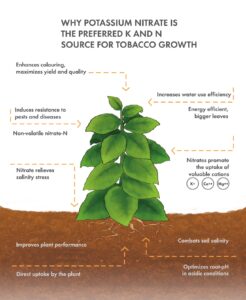Due to the high rainfall in the tobacco producing area of Santa Cruz do Sul, Rio Grande do Sul in Brazil it is generally assumed that fertigation is not possible, as the crop does not need to be irrigated. Nevertheless, the rainfall is not well distributed and drip irrigation is beginning to be adopted to supply water in periods of drought. However, this irrigation is not combined with an adequate fertigation program.
During the 2016-2017 season, Japan Tobacco International (JTI) partnered with SQM to establish field trials at JTI's global research center. The objective of this work was to compare different systems of fertilisation to maximize production potential and yield quality.
Dripsol® improved sustainable production.
By well-timed application, potential nutrient leaching was reduced in the SQM programme, and frequent applications of fertilisers through the drip lines allowed to keep up with the high crop demand for potassium in the critical crop stages.

Four treatments were tested on plots of 90 m2 in three replicates. The current farmers practice based on soil applied granular fertilisers was compared with a programme improving the N-NO3:N-NH4 balance using Qrop® KaliChili (prilled sodium potassium nitrate) in the first and second side dressing after transplant (Table 1). Additionally two fertigation programmes were carried out with 63 – 88 application moments, including fertilisation after transplant, using Dripsol® formulas (Tables 2 and 3).
Both soil applied fertiliser treatments applied the same amount of fertilizers. Use of Qrop® KaliChili supplied a higher ratio of N-NO3: N-NH4. Both fertigation treatments applied additional meso- and micro-nutrients, and lowered the total amount of phosphate. The two treatments varied in the number of applications and total amount of fertiliser applied with irrigation, and differed in the total ratio N:K2O and N-NO3:N-NH4 supplied to the crop (Table 4). The frequent application allowed to adjust both ratios according to the needs of crop in each development stage.
The trial was closely monitored, frequently measuring irrigation volumes, electrical conductivity of the inlet solution and soil solution at two depths: 20 and 40 cm. Combining the EC readings at the two depths with readouts of tensiometers and soil solution extractors at the two depths allowed to make an assessment of difference between the treatments in nutrient uptake dynamics and leaching of nutrients at the different depths of the soil.
Table 1. Soil applications with granular fertilisers or Qrop® prills.

Table 2. Fertigation programmes with Dripsol® water soluble NPKs in Tobacco.

Table 3. Specifications of fertilisers used in the fertirrigation of tobacco (% nutrients).

1 50% Zn EDTA 15% or 50% Mn EDTA 13% and remainder zinc and manganese sulphate: 2 all iron as Fe EDTA 13%; 3 16% Zn EDTA 15% and remainder zinc sulphate.
Table 4. Total nutrients supplied with each fertiliser programme.

Yield and farmers revenue
Tobacco yields and quality indexes following all SQM programmes were superior to the control, the farmers practice, increasing the net revenue of the farmer by 11-40% (Table 5). Highest revenue was obtained following the fertigation treatment 3, despite the greater yield in treatment 4. Lower gross revenue in treatment 4 was caused by lower price received for the tobacco due to its relatively lower quality index (which was still higher compared to farmers practice). A lower sugar: alkaloid content of the leaves contributed most to the lower quality, suggesting there is room for improvement by adjusting the timing of the potassium supply.
Nutrient uptake and leaching: comparing soil application with fertigationThe farmers treatment with soil applied granular fertilisers resulted in an EC higher than 0,8 mS/cm at a depth of 40 cm, in the first phase of plant development till 25 days after transplant. This indicates leaching of nutrients, due to the application of fertilizers in high quantities in combination with high rainfall in this development phase when crop demand for nutrients is low.
Additionally in the period of maximum nutrient demand of the crop, 35-85 days after transplanting, the EC at both depths showed a rapid decline, indicating that the supply of nutrients could not meet the need of the plant. This is in sharp contrast with treatment 4, where 100% of the fertilisers was applied with irrigation. Here EC levels at 40 cm soil depth were low (below 0,2 mS/cm) during most of the crop cycle. The frequent applications through the drip-lines, allowed to keep up the EC at 20 cm depth (location of the most active roots) during the crop development phase between 35 and 85 days, showing that fertigation helps to meet the high demand for nutrients by tobacco in that period.
Table 5. Yield assessment and farmers revenue and income

* Qualit index is defined by a number of analyses, a.o. colour, elasticity, sugar content, nicotine content. Price is also defined by a number of additional parameters not included in the quality index.
What is next?
For the 2017-2018 season JTI together with SQM decided to repeat this experience, and modify treatment 4 in order to further increase the quality index. Additionally and due to the excellent results, JTI decided to implement a semi commercial area where the SQM nutritional programs will be tested on traditional varieties and highly productive varieties. With the results of this second season JTI intends to transfer this technology to a part of its producers, and asked the SQM team to continue providing technical knowledge to elaborate the nutrition programmes, assist in training of the producers and provide field support.



